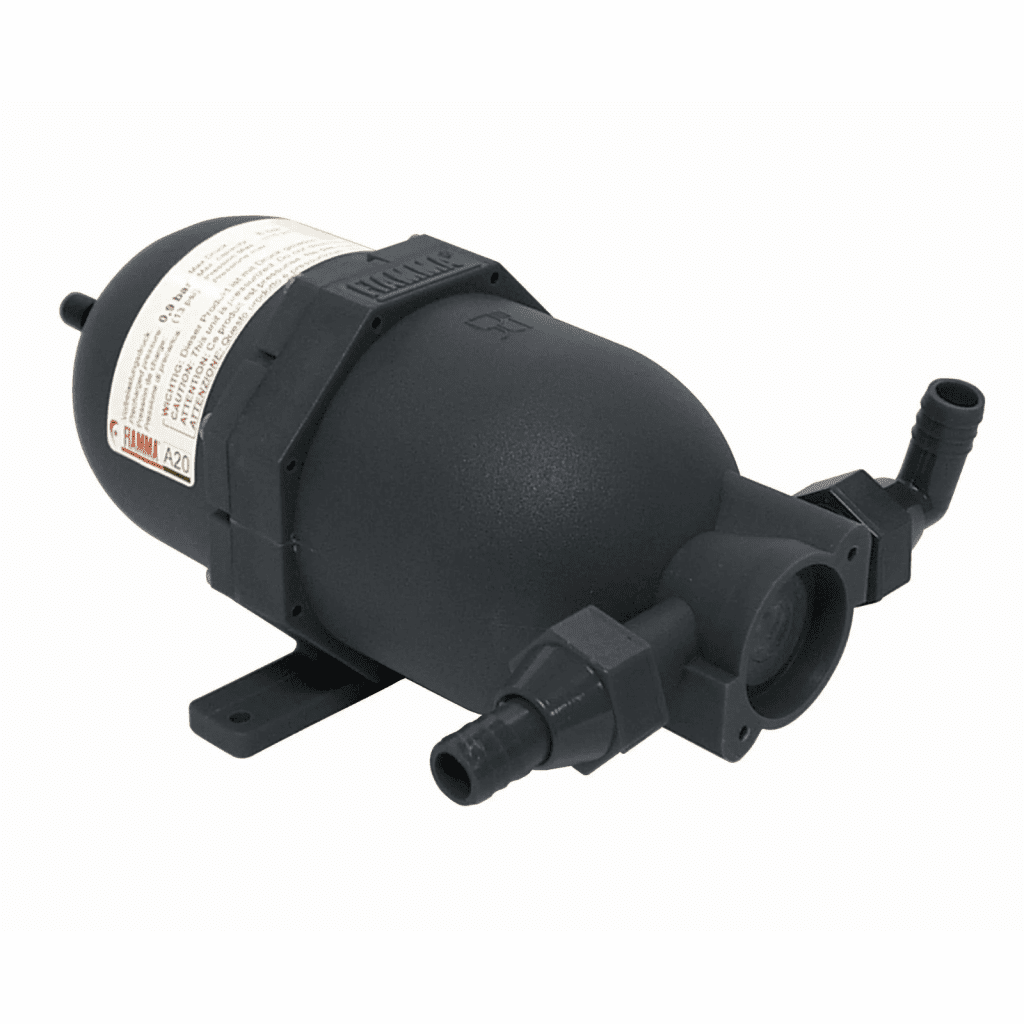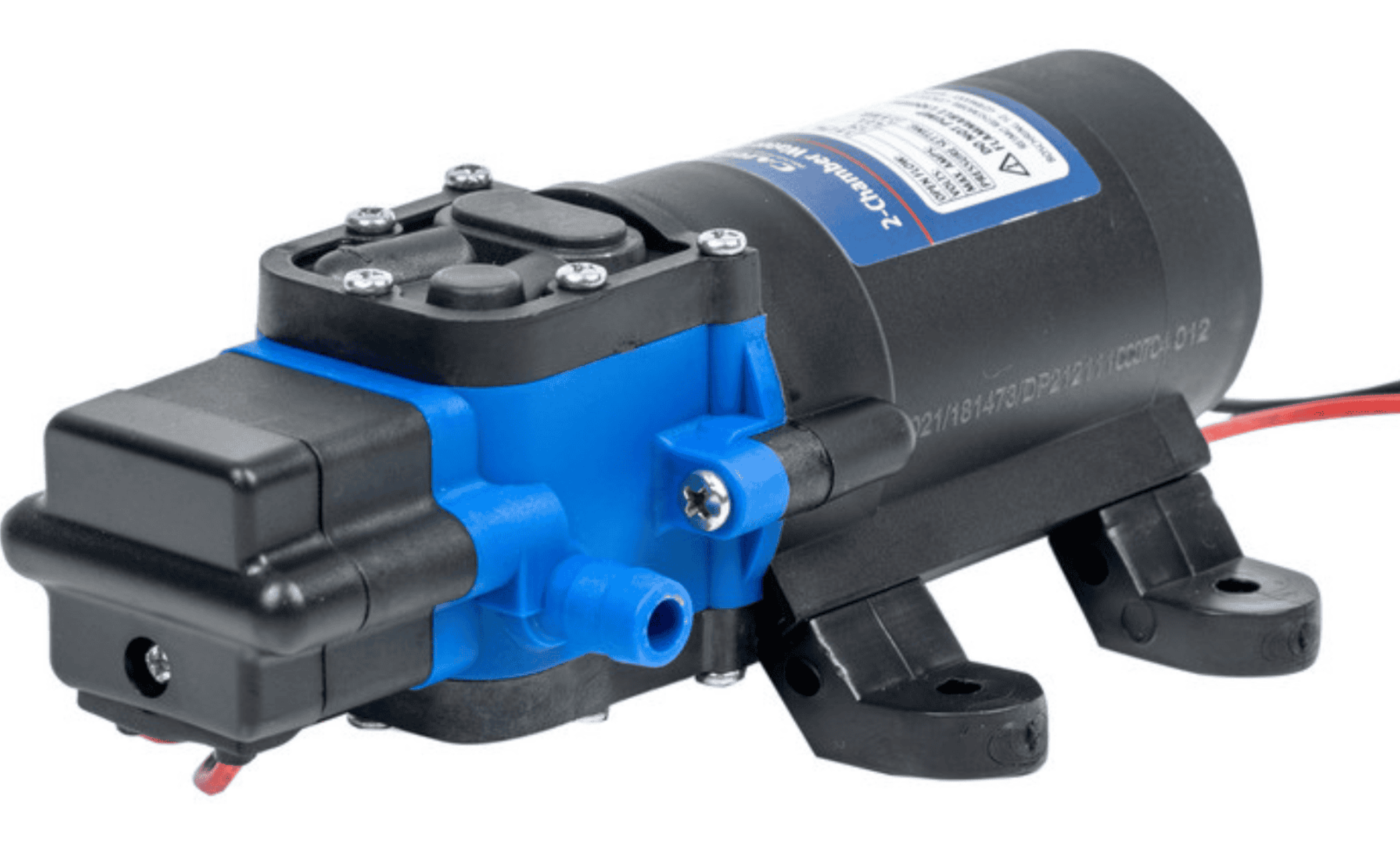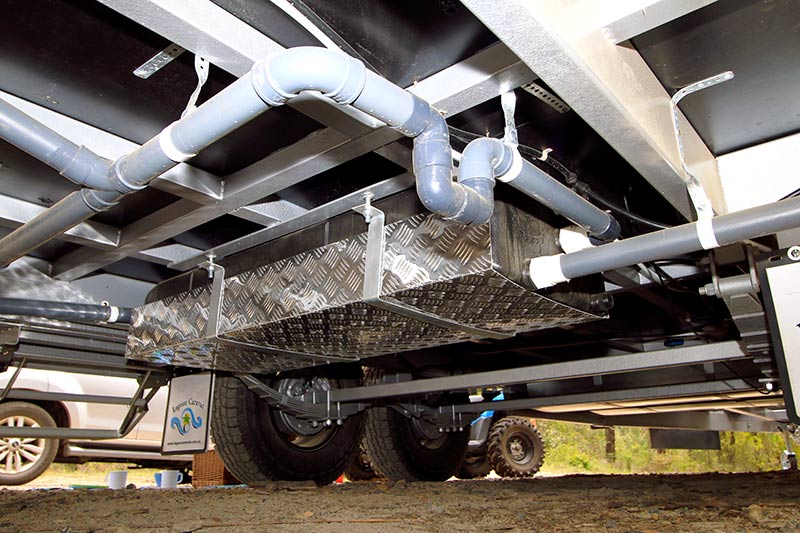Imagine the tranquility of your off-grid campervan, the only sounds being the gentle breeze and the rustling leaves. Then, you turn on the tap, and the peace is shattered by the insistent, pulsating whine of your water pump kicking on and off for even the smallest trickle. This is a common frustration for many campervan owners, but there’s a simple yet remarkably effective solution: the accumulator tank. Often overlooked, this component can transform your onboard water system, enhancing comfort, extending equipment life, and even saving energy. Let’s delve into the world of accumulator tanks and explore why one might be the perfect addition to your home on wheels.
What Exactly is an Accumulator Tank? Breaking Down the Basics
In the realm of plumbing and water systems, an accumulator tank is essentially a vessel designed to store water under pressure, thereby ensuring a more consistent and reliable water supply. Think of it as a buffer in your water line. Internally, these tanks typically feature two chambers separated by a flexible diaphragm or a rubber membrane . One chamber is filled with water from your pump, while the other is pressurised with air or sometimes nitrogen. When you open a tap, the pressurised gas in the tank pushes the stored water out, providing an immediate and smooth flow . This happens even before your main water pump needs to activate. After use, during periods of low water demand, the tank refills, ready for the next time you need water .
Specifically within a campervan conversion, an accumulator tank serves the crucial role of a pressure vessel that stores water under pressure . This seemingly simple function has profound implications for the overall performance and user experience of your mobile water system. By having this reserve of pressurised water readily available, the often-intermittent nature of a campervan’s electric water pump can be effectively managed, mimicking the experience of a constant mains water connection.
How Does It Work Its Magic? Understanding the Mechanics in Your Campervan
The integration of an accumulator tank into your campervan’s water system involves a close interaction with the water pump. Typically, the tank is installed near the discharge port of the pressurised water pump, acting as a vital pressure buffer. When a faucet is opened, the initial flow of water comes from the accumulator tank, propelled by the pre-charged air within. As water is drawn from the tank, the pressure inside it begins to decrease. Once the pressure drops to a certain threshold, known as the pump’s cut-in pressure, the water pump automatically activates to replenish the water in the tank and restore the pressure . The pump will continue to run until the pressure reaches its cut-out point, at which time it will automatically switch off, ready for the cycle to begin again.
This interplay between the accumulator tank and the water pump significantly influences the pump’s operational cycles. Without an accumulator tank, the pump would likely switch on and off rapidly, especially when only a small amount of water is needed. This frequent cycling can be detrimental to the pump’s lifespan. However, with an accumulator tank in place, a reserve of pressurised water is available, meaning the pump only needs to engage when a larger volume of water is required or when the pressure in the tank has noticeably dropped . This demand-driven operation, facilitated by the accumulator, leads to a much smoother and more consistent water flow at your faucets and shower .
The Sweet Benefits: Why Every Campervan Should Consider an Accumulator Tank
The inclusion of an accumulator tank in a campervan water system offers a multitude of advantages that contribute to a more comfortable, efficient, and reliable mobile living experience.
Reducing Water Pump Cycling and Extending Pump Lifespan
One of the primary benefits of an accumulator tank is its ability to significantly reduce the frequency with which your water pump turns on and off . This constant on-off cycling puts considerable strain on the pump’s motor, potentially leading to premature wear and a shortened lifespan . By providing a readily available reserve of pressurized water, the accumulator tank ensures that the pump only needs to activate when a substantial amount of water has been used or the pressure has dropped significantly . This reduction in cycling translates directly to less wear and tear on the pump, ultimately extending its operational life and potentially saving you the cost of more frequent replacements. Considering the investment in a quality water pump, this benefit alone makes an accumulator tank a worthwhile addition.
Providing Smoother and More Consistent Water Flow
Anyone who has experienced the pulsating water flow common in campervan water systems without an accumulator can appreciate the value of a smooth and consistent stream. An accumulator tank acts as a pressure buffer, effectively eliminating those annoying pressure fluctuations and pulsations . When you open a tap, the pressurised air within the tank pushes the water out at a steady rate, providing a consistent flow that feels much more like a residential plumbing system . This is particularly beneficial for tasks like showering, where a consistent water pressure and temperature are highly desirable . Similarly, when washing dishes or performing other tasks that require a steady flow of water, the accumulator tank ensures a more pleasant and efficient experience .
Reducing Noise and Vibration
The on-off cycling of a water pump can be a significant source of noise and vibration within the confined space of a campervan. By reducing the frequency of these cycles, an accumulator tank contributes to a much quieter and more peaceful environment inside your vehicle . The pump will run for longer periods but less often, resulting in fewer disruptive start-ups and shut-downs. Furthermore, when installing your water system, using flexible tubing in conjunction with an accumulator tank can further minimize the transmission of any residual noise and vibration throughout the van’s structure . This combination can make a substantial difference in the overall comfort and livability of your campervan.
Conserving Energy (Battery Power)
For those relying on battery power in their campervans, energy conservation is paramount. Since an accumulator tank reduces the number of times your water pump needs to activate, it also leads to lower overall energy consumption . The pump only draws power when it’s actively replenishing the pressure in the tank, rather than cycling on for every small demand. This can be particularly advantageous for extended off-grid adventures, helping to prolong the life of your batteries and reduce the reliance on charging sources like solar panels or a generator. The fact that the accumulator tank itself doesn’t require any electricity to function further enhances its energy-saving benefits .
The advantages of incorporating an accumulator tank into a campervan water system are clearly interconnected. By stabilising the water pressure, the pump operates less frequently and more efficiently, leading to a cascade of benefits including extended pump life, a more comfortable user experience with smoother water flow, a quieter living environment, and reduced energy consumption.
Finding the Right Fit: Types and Sizes of Accumulator Tanks for Your Campervan Conversion
The most common type of accumulator tank utilized in campervans is the bladder or diaphragm type. These tanks, often constructed from plastic, steel, or stainless steel, contain an internal rubber bladder or diaphragm that separates the water from the pressurised air or nitrogen . Sizes for campervan accumulator tanks typically range from compact units around 0.75 litres (approximately 23.5 ounces) to larger options holding several litres . The ideal size for your campervan will depend on several factors, including:
- Water pump flow rate: Pumps with higher flow rates might benefit from a slightly larger accumulator tank to effectively manage the increased water volume.
- Number of water outlets: If your campervan has multiple faucets or a shower, a larger tank might be preferable to maintain pressure when using more than one outlet simultaneously.
- Frequency and duration of water usage: For individuals or couples who use small amounts of water frequently (e.g., washing hands, brushing teeth), a smaller tank might suffice. However, for those who take longer showers or use more water for cooking and cleaning, a larger tank can help delay pump activation and provide a more consistent experience .
- Available space in the campervan: Space is often at a premium in a campervan conversion, so the physical dimensions of the accumulator tank will be a significant consideration.
- Desired level of pump cycling reduction: If minimizing pump cycling is a top priority, opting for a larger accumulator tank will generally be more effective .
Some manufacturers offer integrated units that combine the water pump and the accumulator tank into a single package . These can be a convenient and space-saving solution for some installations.
For most standard campervan conversions featuring a sink and perhaps a shower, an accumulator tank with a capacity between 0.5 and 2 liters often strikes a good balance between performance and space efficiency.
Table 1: Common Accumulator Tank Sizes and Considerations
| Typical Capacity (litres/oz) | Pros | Cons | Suitable Campervan Setup |
|---|---|---|---|
| 0.75 L / 23.5 oz | Very compact, lightweight, affordable, noticeable reduction in pump cycling for minor water usage | May cycle more frequently with heavier use, limited pressurized water reserve | Single sink, occasional light water usage |
| 2 L / 67.6 oz | Good balance of size and performance, effective reduction in pump cycling for regular usage | Takes up more space than smaller units | Sink and shower, regular water usage |
| 5 L / 169 oz | Significant reduction in pump cycling, larger pressurized water reserve for extended usage | Requires more installation space, heavier | Multiple outlets, frequent and extended water usage |
Troubleshooting Time: Common Problems and How to Tackle Them
While generally reliable, accumulator tanks in campervans can sometimes experience issues. Being aware of these potential problems and their solutions can help you maintain a well-functioning water system.
- Loss of pre-charge pressure: Over time, the air pressure within the accumulator tank can decrease, leading to more frequent pump cycling and reduced effectiveness . The solution is to periodically check the pre-charge pressure using a tire gauge and re-pressurize the tank to the manufacturer’s recommended level, which is typically slightly below the water pump’s cut-in pressure .
- Leaks from the tank or fittings: Leaks can occur at the connections or from the tank body itself, resulting in a loss of system pressure and wasted water . Regularly inspect all fittings for tightness and the tank for any signs of cracks or damage. Tighten any loose fittings and replace damaged components as needed.
- Bladder failure: The internal bladder or diaphragm can rupture due to wear and tear, excessive pressure, or other factors . Symptoms of bladder failure can include a waterlogged tank (feeling unusually heavy), rapid and frequent pump cycling, and water escaping from the air valve when pressed . In most cases of bladder failure, the entire accumulator tank will need to be replaced as replacement bladders are generally not available .
- Incorrect pressure setting: Setting the pre-charge pressure too high or too low can negatively impact the performance of your water system . Always refer to your water pump’s specifications for the correct cut-in pressure and adjust the accumulator tank’s pre-charge accordingly.
It’s important to note that while an accumulator tank helps regulate water pressure within the pump’s operating range, it won’t boost low incoming water pressure from an external source. For that, a separate booster pump might be necessary. Additionally, an accumulator tank doesn’t protect your system from excessively high external water pressure; a pressure regulator should be installed at the water inlet for this purpose .
Getting It Installed: A Practical Guide for Your Campervan
Proper installation is crucial for the optimal performance of your accumulator tank. Here’s a general guide to the process:
- Location: Choose a location on the pressurized side of your water system, meaning after the water pump and before any filters or water outlets . Ideally, it should be installed close to the pump’s discharge port . Ensure the chosen location is easily accessible for future maintenance and inspection.
- Mounting: Securely mount the accumulator tank to prevent any movement or damage, especially during travel . This might involve using sturdy straps, stainless steel bands, or a wooden cradle, depending on the tank design and your campervan’s structure.
- Plumbing Connections: Purge any water from your existing water lines to minimise spillage. Connect the accumulator tank to the plumbing using appropriate fittings and ensure all connections are tight and leak-free. For plastic or nylon threaded fittings, tighten them approximately half to one turn after they are hand-tightened, never exceeding the manufacturer’s recommended torque (typically around 6 ft/lbs) . Remember that ports often seal on an internal taper, not the threads themselves.
- Pre-charge Pressure: Before using the system, you’ll need to set the pre-charge pressure in the accumulator tank. Refer to your water pump’s manual to determine its cut-in pressure. With the water pump turned off and a faucet open to relieve any pressure in the system, use a standard tire pressure gauge to check the pressure at the Schrader valve on the accumulator tank . Adjust the pressure by adding or releasing air until it matches the pump’s cut-in pressure . Replace the valve stem cap tightly to prevent air leakage .
- System Re-pressurisation: Once the tank is plumbed and the pre-charge is set, turn your water pump back on and allow the system to re-pressurise. Check all connections for any leaks.
For optimal noise reduction, consider using flexible, braided tubing to connect the water pump to the accumulator tank . It’s also worth noting that some Shurflo water pump models, specifically the 4900 and 5900 series, are not recommended for use with accumulator tanks, so always check the compatibility of your equipment .
Keeping It Running Smoothly: Essential Maintenance Tips
To ensure the longevity and proper functioning of your accumulator tank, regular maintenance is key:
- Check Pre-charge Pressure: It’s recommended to check the pre-charge pressure at least once or twice a year, or whenever you notice your water system’s performance has declined . Use a tire pressure gauge on the Schrader valve to verify the pressure.
- Adjust Pressure as Needed: If the pressure is too high or too low, adjust it according to the manufacturer’s recommendations and your water pump’s specifications. Remember to depressurise the water system before checking or adjusting the pre-charge .
- Winterisation: If you live in or travel to areas with freezing temperatures, it’s crucial to winterise your entire water system, including the accumulator tank, by draining all water or adding potable RV antifreeze . Never use automotive antifreeze as it is toxic . For complete drainage during winterisation, mounting the tank with the pre-charge valve stem facing upwards is often recommended .
- Inspect for Leaks and Corrosion: Periodically examine the accumulator tank and all associated fittings for any signs of leaks or corrosion . Address any issues promptly to prevent further damage or water loss.
Conclusion: Is an Accumulator Tank the Missing Piece in Your Campervan Water Puzzle?
For campervan owners seeking a quieter, smoother, and more efficient water system, the accumulator tank stands out as a remarkably effective upgrade. By reducing the incessant cycling of your water pump, it not only extends the pump’s lifespan but also provides a more consistent and enjoyable water flow for everyday tasks like showering and washing dishes. The added benefit of noise reduction contributes significantly to the overall comfort of your mobile living space, and the potential for energy savings is a welcome advantage for off-grid adventurers. While choosing the right size and ensuring proper installation and maintenance are important considerations, the overall benefits of an accumulator tank make it a valuable addition to almost any campervan conversion. If you’re tired of the noisy, jerky water flow in your van, it might just be the silent hero your water system has been waiting for.




